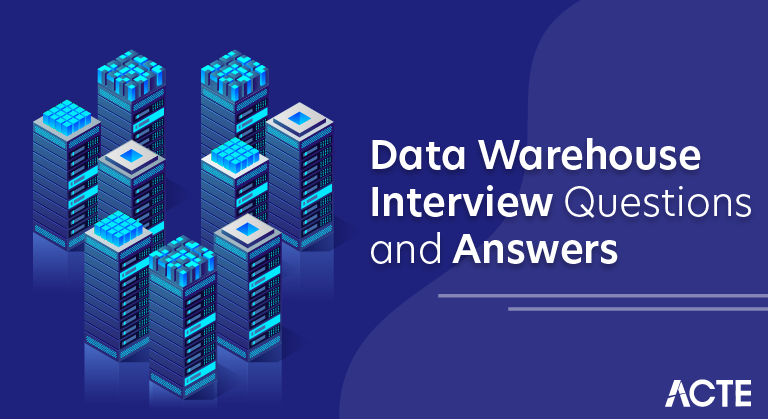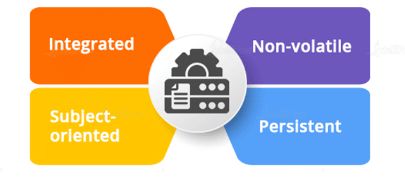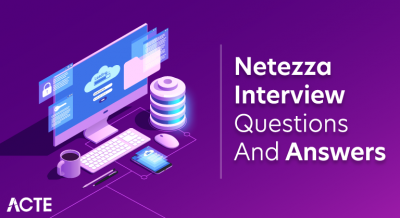
A data warehouse is a centralized repository that stores and manages large volumes of structured and unstructured data from various sources. It is designed for analytical processing, enabling businesses to extract valuable insights and support decision-making. Data warehouses integrate data through Extract, Transform, Load (ETL) processes, organize it using schema designs, and often maintain historical records for trend analysis. Utilizing tools like Business Intelligence (BI), data warehouses facilitate efficient querying and reporting, optimizing data accessibility and analytical capabilities.
1. What is the definition of a data warehouse?
Ans:
A data warehouse is a centralized repository for storing and managing large volumes of structured, historical data from different sources within an organization. It is designed for efficient querying and analysis, providing a comprehensive view of the business to support decision-making processes.
2. What are some different names for the data warehouse system?
Ans:
Data warehouses are also referred to as
- Enterprise Data Warehouses (EDW)
- Decision Support Systems (DSS)
- Data Marts
- Business Intelligence Data Warehouses
3. What exactly do you mean by “data mining”?
Ans:
Data mining is the process of identifying patterns, trends, and valuable insights in massive databases. It employs statistical approaches, machine learning algorithms, and data analysis to extract valuable knowledge and information from raw data.
4. What are the different kinds of fact tables?
Ans:
Transaction Fact Table: Records individual business transactions.
Periodic Snapshot Fact Table: Captures data at predefined intervals.
Accumulated Snapshot Fact Table: Stores cumulative data at multiple predefined intervals.
5. What do you mean by OLAP in relation to data warehousing?
Ans:
OLAP (Online Analytical Processing) is a data warehousing word that refers to a set of tools and technologies that enable interactive analysis of multidimensional data. OLAP allows users to study and evaluate data from several perspectives, allowing for more complex queries and business intelligence reporting.
6. What principles should be followed while choosing an OLAP system?
Ans:
- Consider factors such as scalability, performance, ease of use, and compatibility with existing infrastructure.
- Evaluate the OLAP system’s ability to handle complex queries and provide interactive analysis.
- Ensure support for various data modeling techniques and multidimensional data structures.
- Consider the level of integration with existing reporting and analytics tools.
7. What exactly do you mean by “dimension table”?
Ans:
A dimension table in a data warehouse contains descriptive attributes that provide context and details about the data stored in the fact table. It is typically joined with the fact table to provide meaningful information for analysis.
8. What are the advantages of having a data warehouse?
Ans:
- Improved Decision-Making
- Data Quality and Consistency
- Enhanced Reporting and Analysis
- Data Integration
- Support for Business Intelligence
9. What are the different kinds of dimension tables?
Ans:
Slowly Changing Dimension (SCD): Captures changes to dimensional data over time.
Junk Dimension: Consolidates minor, low-cardinality attributes into a single-dimension table.
Role-Playing Dimension: Represents the same dimension with different roles in a single fact table.
10. What does “active data warehousing” imply to you?
Ans:
Active data warehousing involves real-time or near-real-time updates to the data warehouse. It implies that the data warehouse actively integrates and reflects changes as they occur in the source systems, enabling more timely decision-making.
11. What kinds of data marts are there in data warehousing?
Ans:
Dependent Data Mart: Extracts data directly from the enterprise data warehouse (EDW).
Independent Data Mart: Created independently of the EDW, often for a specific department or business unit.
Hybrid Data Mart: Combines elements of both dependent and independent data marts.
12. What knowledge do you have regarding metadata?
Ans:
- Metadata refers to data about data in a data warehouse.
- It includes information about data sources, transformations, business rules, and the structure of the data warehouse.
13. What characteristics make up a data warehouse?
Ans:
Subject-Oriented: Organized around business subjects or areas.
Integrated: Consolidates data from diverse sources for consistency.
Time-Variant: Stores historical data to analyze trends over time.
Non-Volatile: Data is not frequently updated; emphasis on historical accuracy.

14. What are the benefits of data warehouse architecture using a top-down approach?
Ans:
- A top-down approach ensures a holistic and comprehensive view of the entire organization’s data.
- Centralized control promotes consistency in data definitions and business rules across different departments.
- Aligns with the organization’s strategic goals, ensuring that the data warehouse supports overarching business objectives.
15. List a few data warehouse systems that the business is presently using.
Ans:
Microsoft SQL Server Analysis Services (SSAS): Provides OLAP and data mining capabilities.
Oracle Exadata: Integrates database and storage for high-performance analytics.
IBM Db2 Warehouse: Supports data warehousing and analytics.
Snowflake: A cloud-based data warehousing platform.
16. When you refer to snowflake schema in data warehousing, what do you mean?
Ans:
In a star schema, a central fact table is connected to multiple dimension tables. The fact table contains quantitative data, and dimension tables provide descriptive context. It resembles a star when visualized, with the fact table at the center and dimensions radiating out.
17. List a few of the well-known ETL tools that are now in use in the sector.
Ans:
- Informatica PowerCenter
- Microsoft SQL Server Integration Services (SSIS)
- Apache NiFi
- Talend
18. Differentiate between data mining and data warehousing.
Ans:
| Feature | Data Mining | Data Warehousing | |
| Purpose |
Extracting patterns or knowledge from data |
Storing, managing, and retrieving data | |
| Focus | Analysis and discovery | Storage and retrieval | |
| Objective |
Uncovering hidden patterns or trends |
Centralized storage for analytical use | |
| Process | Analyzing large datasets for insights | Extract, transform, load (ETL) processes |
19. What does “real-time data warehousing” mean to you?
Ans:
- Real-time data warehousing involves updating and querying the data warehouse in near-real-time.
- It allows organizations to make decisions based on the most current information available.
20. In data warehousing, what do you mean by dimensional modeling?
Ans:
Dimensional modeling is a design concept used in data warehousing to structure and organize data for efficient querying and analysis. It involves creating a logical model that represents business entities and their relationships in a way that facilitates easy retrieval of information.
21. Describe the data warehouse’s architecture.
Ans:
Data warehouse architecture is the structure that defines how a data warehouse is organized, the components it consists of, and how data flows within the system. It typically involves various layers and processes designed to support the storage, retrieval, and analysis of large volumes of data. The main components include:
- Source Systems
- ETL (Extract, Transform, Load) Layer
- Data Storage
- Data Access Layer
22. Distinguish between Divisive and Agglomerative Hierarchical Clustering.
Ans:
Divisive Hierarchical Clustering: Divisive hierarchical clustering is an approach where the clustering process starts with a single cluster containing all data points and progressively divides it into smaller clusters.
Agglomerative Hierarchical Clustering: Agglomerative hierarchical clustering takes the opposite approach, beginning with individual data points and gradually merging them into larger clusters. In this method, clusters are iteratively combined based on their similarity, creating a hierarchical structure.
23. Describe your understanding of a star schema.
Ans:
In a star schema, a central fact table is connected to multiple dimension tables. The fact table contains quantitative data, and dimension tables provide descriptive context. It resembles a star when visualized, with the fact table at the center and dimensions radiating out.
24. Define the data warehousing ER diagram.
Ans:
- The data warehousing Entity-Relationship (ER) diagram visually represents the relationships between entities in a data warehouse.
- It illustrates how different tables, such as fact and dimension tables, are connected and how data flows within the warehouse.
25. What roles do warehouse managers play?
Ans:
Data Governance: Ensuring data quality, security, and compliance.
Performance Monitoring: Overseeing the data warehouse’s efficiency.
Capacity Planning: Managing resources and scalability.
Metadata Management: Handling metadata for effective data governance.
User Support: Assisting users with queries and access.
26. What does virtual data warehousing mean?
Ans:
Virtual data warehousing refers to the practice of accessing and querying data without physically moving or storing it in a centralized repository. It leverages virtualization techniques to provide a unified view of data from disparate sources, allowing users to query and analyze information in real time without the need for extensive data movement or storage.
27. Explain a data warehousing snapshot.
Ans:
- A data warehousing snapshot is a point-in-time representation of data in a data warehouse.
- It captures the state of the data at a specific moment, allowing users to analyze historical changes over time.
28. List the three primary purposes of dimensions.
Ans:
Filtering and Slicing: Dimensions allow users to filter data and slice it from various perspectives, focusing on specific subsets of information.
Grouping and Aggregating: Dimensions enable the grouping and aggregation of data, providing a higher-level view for analysis.
Drilling Down and Rolling Up: Dimensions support the drill-down and roll-up operations, allowing users to explore data at different levels of granularity.
29. Describe the Galaxy Schema.
Ans:
A Galaxy Schema is a variation of the star schema used in dimensional modeling. In a Galaxy Schema, multiple fact tables share common dimension tables. This design allows for more complex relationships between fact tables, providing greater flexibility in handling diverse business scenarios.
30. What benefits might a cloud-based data warehouse offer?
Ans:
Scalability: Easily scales resources up or down based on demand.
Cost Efficiency: Pay-as-you-go pricing model reduces upfront costs.
Flexibility: Allows for quick deployment and integration with other cloud services.
Accessibility: Enables remote and distributed access to data.
Automatic Updates: Cloud providers handle maintenance and updates.
31. In a data warehouse, what is an aggregate table?
Ans:
An aggregate table in a data warehouse is a precomputed summary table that contains aggregated or summarized data. It stores aggregated values, such as totals or averages, for a subset of dimensions. Using aggregate tables enhances query performance by reducing the need to perform complex calculations on the detailed data in the fact table, especially for frequently executed queries.
32. What does hybrid SCD mean to you?
Ans:
Hybrid SCD refers to a combination of different strategies for managing changes in dimension tables over time. It may involve using both Type 1 (overwrite) and Type 2 (add new version) approaches based on the nature of the data and the requirements of the business. This hybrid approach balances simplicity and historical tracking.
33. How many dimensions are there in a dice operation?
Ans:
In a dice operation, the number of dimensions specifies the subset of data to be selected or “sliced” for analysis. The dice operation is performed along specific dimensions, allowing users to focus on a particular combination of attribute values within those dimensions.
34. Give three definitions for SCD.
Ans:
Type 1 SCD (Overwrite): Updates existing records with new data, overwriting the old values.
Type 2 SCD (Add New Version): Adds a new version of a dimension record when changes occur, preserving historical data.
Type 3 SCD (Add New Attribute): Adds a new attribute to the existing dimension, capturing changes but in a limited way.
35. Describe the primary advantage of normalization.
Ans:
The primary advantage of normalization is the reduction of data redundancy and dependency. By organizing data into separate tables and eliminating duplicate information, normalization minimizes the risk of anomalies, enhances data integrity, and ensures efficient storage.
36. What does VLDB mean?
Ans:
- VLDB refers to a database that is exceptionally large in terms of data volume and complexity.
- Managing VLDBs requires specialized strategies for storage, indexing, and query optimization to ensure efficient performance.
37. Describe the Junk Dimension.
Ans:
A Junk Dimension is a dimension table that consolidates minor, low-cardinality attributes that do not fit well into other dimensions. It simplifies the data model by grouping miscellaneous attributes into a single-dimension table, reducing the number of joins in queries.
38. What duties does the query manager have to perform?
Ans:
Optimizing Queries: Ensuring that queries are written and executed efficiently.
Performance Tuning: Improving the overall performance of database queries.
Resource Allocation: Allocating and managing resources to meet query processing demands.
39. What kind of facts aren’t additive?
Ans:
Non-additive facts are types of data that do not support aggregation across all dimensions. These facts cannot be summed up or aggregated when certain dimensions are involved. Examples of non-additive facts include ratios, percentages, and averages. Aggregating these types of facts without considering the specific context or dimension can lead to incorrect or misleading results.
40. Explain conformed dimensions.
Ans:
Conformed dimensions are dimensions that have consistent meaning and content across multiple data marts or data sources within an organization. These dimensions provide a standardized reference across different parts of a data warehouse, ensuring that the same set of attributes and values can be used and understood uniformly.
41. What separates a view from a materialized view?
Ans:
View:
- A view is a virtual table that is based on the result of a SELECT query.
- It does not store data itself but provides a way to represent a subset of data from one or more tables.
Materialized View:
- A materialized view, on the other hand, is a physical copy of the result set of a query that is stored in the database.
- Unlike a view, a materialized view is precomputed and persistently stored.
42. Define the term “OLAP cube” and explain its significance in data analysis.
Ans:
An OLAP (Online Analytical Processing) cube is a multidimensional data structure that allows users to analyze and navigate data from different dimensions simultaneously. It organizes data into a cube format, where each cell represents a unique intersection of dimensions, such as time, geography, and product.
43. When is the surrogate key used in data warehousing?
Ans:
A surrogate key is used in data warehousing when there is a need for a unique, artificial identifier for each record in a dimension table. It is typically an integer or a system-generated value that serves as a primary key, replacing or supplementing the natural key.
44. Explain the concept of slowly changing dimensions (SCD).
Ans:
Slowly Changing Dimensions (SCD) refers to dimensions in a data warehouse that change over time.
45. Describe the advantages of denormalization in a data warehouse.
Ans:
- Improved Query Performance
- Simplified Data Retrieval
- Aggregation Efficiency
- Enhanced Read Operations
- Support for Reporting
46. What is the fact table’s degree of detail?
Ans:
The fact table’s degree of detail refers to the level of granularity or specificity at which data is recorded in the fact table. It indicates the extent of detail captured for each transaction or event. The degree of detail is determined by the level of information needed for analysis and reporting.
47. What is the Data Warehousing aim of cluster analysis?
Ans:
Cluster analysis in data warehousing aims to identify natural groupings or clusters within a dataset based on similarity or proximity. By grouping similar data points, cluster analysis helps in understanding patterns and relationships and segmenting data for more effective decision-making.
48. Describe XMLA.
Ans:
- XMLA, or XML for Analysis, is a standard protocol for accessing and manipulating analytical data sources, particularly in the context of OLAP (Online Analytical Processing) and data mining.
- It uses XML-based messages to communicate with multidimensional data sources, allowing for tasks such as querying, browsing, and managing OLAP cubes.
49. What is the purpose of the chameleon approach in data warehousing?
Ans:
The chameleon approach in data warehousing refers to a flexible modeling strategy that adapts to changing business requirements. The purpose is to design a data warehouse architecture that can evolve, accommodating new data sources, business dimensions, or analytical needs seamlessly.
50. What is SCD that is Hybrid?
Ans:
A Hybrid SCD combines elements of different SCD types (e.g., Type 1 and Type 2) to address specific business requirements. In this approach, specific attributes within a dimension may be treated as Type 1 (overwritten) when changes occur, while others are managed as Type 2 (new version added), preserving historical information.
51. What is meant by “data purging”?
Ans:
- Data purging is the process of permanently eliminating or removing information from a database, data warehouse, or other data storage system.
- This activity is often conducted to free up storage space, enhance system efficiency, and eliminate old or redundant data.
52. What makes us in Struts override the execute method?
Ans:
In Struts, the ‘execute’ function is frequently altered to specify the primary processing logic for an Action class. Struts is a web application framework that supports Java-based corporate applications. By overriding the ‘execute’ function, developers may define which actions should be performed when a specific action is requested.
53. What is meant by the action of slicing?
Ans:
In the context of OLAP (Online Analytical Processing), the action of slicing refers to the operation of extracting a subset of data from a multidimensional cube along a single dimension. Slicing allows users to focus on a specific “slice” or cross-section of the data, viewing information at a particular level of granularity along one dimension while keeping the other dimensions unchanged.
54. Explain the concept of data lineage in the context of data warehousing.
Ans:
- Data lineage refers to the tracking of the flow and transformation of data from its origin to its final destination within a data warehouse.
- It provides a visual representation of how data moves through various processes, transformations, and storage layers, enhancing transparency and traceability.
55. What is a star join optimization?
Ans:
Star join optimization is a technique used to enhance query performance in a star schema by optimizing the execution of join operations between the fact table and dimension tables. It involves creating indexes, using bitmap indexes, or employing other optimization strategies to expedite queries and reduce response times.
56. How do you handle dimension hierarchies in a data warehouse?
Ans:
Common approaches to handling dimension hierarchies include:
Snowflake Schema: Normalizing dimension tables to create a structured hierarchy. For example, breaking down time into year, quarter, month, and day tables.
Parent-Child Relationships: Establishing relationships between rows within the same dimension table to represent hierarchies.
Denormalization: Including redundant data in the dimension table to simplify queries and improve performance.
57. How do you approach capacity planning for a data warehouse?
Ans:
Capacity planning for a data warehouse involves anticipating future data growth and query loads. This process includes analyzing historical data growth patterns, understanding query complexity, monitoring system performance metrics, and forecasting resource requirements based on business projections.
58. Explain the concept of data archiving in a data warehouse.
Ans:
- Data archiving in a data warehouse focuses on moving older, less frequently accessed data from active storage to a separate archival system.
- This strategy aims to improve query performance, maintain optimal system responsiveness, comply with data retention policies, and reduce storage costs.
59. What is the role of indexing in a data warehouse?
Ans:
Indexing is crucial for optimizing query performance in a data warehouse. Indexes are data structures that facilitate quick access to rows based on column values. While indexes enhance read performance, they can impact write performance and increase storage requirements.
60. What is the role of metadata management in a data warehouse?
Ans:
- Metadata management plays a crucial role in a data warehouse by providing information about the structure, source, and meaning of data.
- It enables data lineage tracking and impact analysis and supports compliance and governance.
61. How do you handle data quality issues?
Ans:
Handling data quality issues involves a comprehensive approach:
Data Profiling: Analyzing the data to identify anomalies, inconsistencies, and missing values.
Data Cleansing: Applying transformations and business rules to correct errors and ensure data conformity.
Validation Rules: Implementation rules to enforce data integrity and quality standards.
Data Monitoring: Continuously monitor and audit data to identify and rectify issues promptly.
62. Explain the concept of data lakehouse.
Ans:
A data lake house combines elements of a data lake and a data warehouse, providing a unified platform for storing raw and processed data. It integrates the flexibility of a data lake with the structure and processing capabilities of a data warehouse. In a data lakehouse, raw data can be ingested and stored alongside curated data, enabling both exploratory analytics and structured reporting.
63. How do you design a data warehouse to support real-time analytics?
Ans:
Designing a data warehouse for real-time analytics involves using technologies like Apache Kafka or Amazon Kinesis for real-time data ingestion and tools like Apache Flink or Apache Spark for stream processing. Ensuring low-latency data processing and optimizing ETL pipelines for real-time updates are essential considerations.
64. How do you optimize a data warehouse for query performance?
Ans:
- Optimizing query performance in a concurrent user environment involves strategies such as query optimization, indexing, caching, and partitioning.
- It also includes resource allocation, workload management, and performance tuning to ensure that the data warehouse can efficiently handle multiple user queries simultaneously.
65. How would you design a data warehouse to handle multi-temperature data storage?
Ans:
Multi-temperature data storage involves categorizing data based on its access frequency. Hot data (frequently accessed) is stored in high-performance storage, warm data (moderately accessed) in mid-tier storage, and cold data (infrequently accessed) in cost-effective storage. This design optimizes storage costs while ensuring quick access to frequently used data.
66. Explain the concept of data deduplication.
Ans:
Data deduplication involves identifying and removing duplicate records from a dataset. In a data warehouse, deduplication helps in maintaining data quality, improving storage efficiency, and ensuring that analytics and reporting are based on accurate and unique information.
67. How do you handle data skewness in a data warehouse?
Ans:
- Data skewness occurs when the distribution of data is uneven across nodes or partitions.
- It’s important to address because it can lead to performance bottlenecks.
68. Explain the concept of data democratization in a data warehouse.
Ans:
Data democratization involves making data accessible to a broader audience within an organization, empowering business users to make data-driven decisions. This approach promotes self-service analytics, reduces dependency on IT, and fosters a culture of informed decision-making across departments.
69. What are the benefits of using in-memory databases in a data warehouse?
Ans:
- In-memory databases store data in the system’s main memory, providing faster query performance.
- Benefits include reduced query response times, improved analytics, and faster data access.
70. Explain the role of data cataloging tools in a data warehouse environment.
Ans:
Data cataloging tools organize and document metadata, making it easier for users to discover and understand available data assets. They enhance collaboration, promote data governance, and provide a centralized repository for metadata, fostering a more efficient and informed data discovery process.
71. How do you approach data integration challenges?
Ans:
Addressing data integration challenges involves a thorough understanding of data sources, data profiling, and employing ETL processes to transform and cleanse data. Middleware tools and technologies may be used to facilitate integration, ensuring that data from diverse sources is harmonized for analytical purposes.
72. Explain the concept of late-arriving dimensions in a data warehouse.
Ans:
Late-arriving dimensions are dimension records that arrive after the corresponding fact records have been loaded. Handling them involves:
- Using techniques such as default values.
- Placeholder records.
- Backfilling to retroactively update the dimension tables without compromising data integrity.
73. Explain the concept of horizontal partitioning in a data warehouse.
Ans:
- Horizontal partitioning involves dividing a table into subsets of rows, typically based on range or hash criteria.
- Horizontal partitioning is beneficial for distributing large tables across nodes.
74. How do you handle data lineage tracking in a distributed data warehouse environment?
Ans:
Data lineage tracking in a distributed environment involves using metadata management tools, ensuring synchronization across distributed repositories, and implementing version control. Challenges may include latency in propagating metadata updates and the need for consistency across distributed systems, requiring careful governance and coordination.
75. Explain the concept of a data vault modeling approach in data warehousing.
Ans:
- Data vault modeling is an approach that focuses on creating a flexible and scalable data warehouse architecture.
- It involves organizing data into hubs, links, and satellites, allowing for incremental changes and adaptability to evolving business requirements.
76. Explain the concept of delta processing in a data warehouse.
Ans:
Delta processing involves capturing and processing only the changes or additions to the data since the last update. It plays a crucial role in efficiently handling incremental data changes, reducing the amount of data that needs to be processed during ETL, and ensuring timeliness in data updates.
77. How do you approach the design of data warehouses?
Ans:
- Designing for both ad-hoc reporting and structured analytics involves creating a flexible schema that accommodates varied data needs.
- A balance between normalized and denormalized structures may be struck to support complex queries and quick, exploratory analysis.
- Ensuring efficient indexing and query optimization is essential for both reporting styles.
78. Explain the concept of columnar storage in a data warehouse.
Ans:
Columnar storage stores data in columns rather than rows, providing benefits such as improved compression, faster query performance, and efficient data retrieval for analytical queries. This storage format is particularly suitable for data warehouses where analytical workloads are typical.
79. How would you address and mitigate the impact of data silos?
Ans:
Data silos refer to isolated datasets that are not easily accessible or integrated with other parts of the organization. They pose challenges in terms of data consistency and collaboration. Mitigating the impact involves implementing data integration technologies, establishing data governance policies, and fostering a culture of cross-functional collaboration.
80. What techniques can be applied to achieve load balancing?
Ans:
- Partitioning
- Data Shuffling
- Dynamic Partitioning
- Load-Balanced Clustering
- Round Robin Distribution
81. Explain the role of data stewardship in a data warehouse.
Ans:
Data stewardship involves managing and ensuring the quality, integrity, and compliance of data within a data warehouse. Responsibilities include defining data quality rules, monitoring data quality metrics, resolving data quality issues, and collaborating with business users and IT teams to maintain high-quality data.
82. What is a data cube in data warehousing, in your opinion?
Ans:
A data cube represents multidimensional data in a three-dimensional space. Dimensions, such as time, geography, and product, intersect to form data points. It enables efficient querying and analysis, especially in OLAP systems.
83. Explain the role of data orchestration in a modern data warehouse architecture.
Ans:
Data orchestration involves coordinating and automating data workflows. A modern data warehouse enhances workflow management by streamlining the execution of ETL processes, ensuring data quality checks, and managing dependencies between tasks. This automation contributes to processing efficiency by reducing manual intervention and optimizing the sequencing of data operations.
84. Describe the concept of data fingerprinting.
Ans:
- Data fingerprinting involves creating unique identifiers for datasets based on their content.
- It ensures data integrity by allowing users to verify the authenticity and consistency of datasets.
- For security, it aids in detecting unauthorized changes or tampering, providing an additional layer of protection against data breaches.
85. Explain the concept of data fusion in a data warehouse.
Ans:
Data fusion involves combining information from multiple sources to create a more comprehensive dataset. In a data warehouse, it contributes to a comprehensive view by consolidating diverse data types and sources. This process enhances analytical capabilities, allowing for a more holistic understanding of business trends and patterns.
86. How does a data custodian differ from the role of a data steward?
Ans:
Data Custodian: Primarily manages the physical storage and security of data assets.Data Steward: Primarily ensures data quality, defines metadata, and aligns data with business requirements.
87. How does data cataloguing contribute to data governance?
Ans:
- Unified Data Inventory
- Metadata Standardization
- Data Lineage Visibility
- Searchable Interface
- Governance Policies Integration
88. What strategies can be employed to maintain transparency and traceability?
Ans:
Metadata Management: Capture and maintain comprehensive metadata for tracking data origin and usage.Data Lineage Tracking: Implement tools to visualize and trace the flow of data.Version Control: Employ version control for data models to track changes.Audit Trails: Implement audit trails to record data modifications.
89. Explain the role of data virtualization in a hybrid cloud data warehouse.
Ans:
Data virtualization in a hybrid cloud data warehouse creates a unified data access layer, allowing seamless integration and querying across diverse sources. It decouples physical storage from logical representation, ensuring flexibility, real-time integration, and cost-efficient data management in hybrid cloud environments.
90. How does data mesh promote domain-oriented ownership?
Ans:
Data Mesh promotes domain-oriented ownership by decentralizing data responsibilities to individual domains. This approach fosters a sense of accountability within each domain, encouraging cross-functional teams to manage and scale their data products independently.






